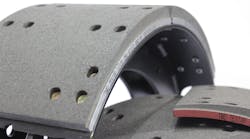Needless to say, proper brake maintenance is essential to commercial vehicle and roadway safety. Improperly installed or poorly maintained brake systems can reduce braking capacity and increase stopping distance of large trucks and buses, posing serious risks to the driver and the public safety.
Yet, brake-related violations comprise the largest percentage of all out-of-service violations cited during roadside inspections, note officials with the Commercial Vehicle Safety Alliance (CVSA), an organization comprised of local, state, provincial, territorial and federal motor carrier safety officials and industry representatives from the United States, Canada and Mexico that promotes commercial motor vehicle safety.
Here are some results from last year’s CVSA Brake Safety Week campaign, wherein in safety officials conduct roadside inspections to identify out-of-adjustment brakes and brake system violations:
- Inspectors from participating agencies inspected 18,817 vehicles throughout Brake Safety Week and placed 2,321 commercial vehicles out of service (OOS) for brake violations.
- Of the vehicles inspected, the OOS rate for all brake-related violations conducted in North America was 12.3 percent compared with 16.2 percent last year.
Automatic brake adjusters (ABAs) play an important role in keeping commercial vehicle brakes operating properly and up to regulatory standards. Here are some recommendations to help keep them in good working order. Be sure to share them with your technicians.
Routine Checks
- Routine visual/operational checks, including brackets and control arms, should be performed at each preventive maintenance (PM) service interval.
- Adjusters or anchor brackets that have visual damage, or which fail the operational checks, must be replaced immediately.
- Automatic adjusters should not be operated as manual adjusters, unless it is necessary to get the vehicle off the road for service.
Maintenance Inspection
Before a maintenance inspection:
- Block the wheels to prevent the vehicle from rolling.
- Ensure that the air system tank pressure is at 90 to 100 psi.
- Check that the push rod is fully retracted.
- Apply air to release spring.
- During normal lubrication intervals, visually inspect the brake adjuster, anchor bracket and control arm for damage. Check that the anchor bracket and control arm are tight and that the control arm is in its correct position.
- Manually de-adjust the brakes (turn the adjustment hex counterclockwise one full turn) to create an excessive drum-to-lining clearance condition. A ratcheting sound should occur.
- Make a full service brake application. On release, allow sufficient time for the brake to fully retract.
- During the brake release, observe the rotation of the adjustment hex. Attaching a wrench on the hex or scribing the hex will make this rotation easier to see.
- This rotation indicates that the brake adjuster has determined an excessive clearance condition, and it is making an adjustment to compensate. On each subsequent brake release, the amount of adjustment and push rod travel will be reduced until the desired clearance is achieved.
- If rotation of the adjustment hex is not observed, refer to your manufacturer’s foundation brake operational check and troubleshooting procedures. If the foundation brake assembly checks out okay and the hex still does not turn, check the control arm and mounting bracket for possible worn, bent or broken components. If the control arm and mounting bracket check out okay, replace the adjuster and hardware per procedures.
Check and Troubleshooting
Before troubleshooting procedures, as with prior to a maintenance inspection, block the wheels to prevent the vehicle from rolling, ensure air system tank pressure is at 90 to 100 psi, check that the push rod is fully retracted and apply air to release the spring.
If the power stroke is at the adjustment limit:
- Check for wear points in the foundation brake (i.e., camshaft and bushings, anchor pins and rollers).
- Check the brake adjuster for a worn anchor bracket connection point.
If the power stroke is 1/4” or more beyond the adjustment limit:
- Check to ensure that the adjuster anchor bracket is connected properly and secured.
- Check that the re-adjustment torque of the adjuster’s one-way clutch is above 13 ft/lbs.
- Check that the foundation brake is not binding and the push rod is fully retracting upon brake release.
If the brakes are tight or dragging:
- Check the position of the adjuster control arm and that the installation indicator is in the slot at full brake release.
- Check that the foundation brake is not binding and the pushrod is fully retracting upon brake release.
- Check wheel bearing torque. Loose bearings can cause tight brakes.
If the automatic brake adjuster is inoperable, it must be replaced. Automatic adjusters cannot be operated as manual adjusters, unless it is necessary to get the vehicle off the road for service.
Proper brake inspection and maintenance can help your fleet from being cited for brake-related violations discovered during a roadside inspection.
Randy Petresh is vice president of technical services for Haldex (www.haldex.com). The company develops and manufactures brake systems for trucks, trailers and buses. Its product offering includes all primary components and subsystems that make up complete air brake systems.





